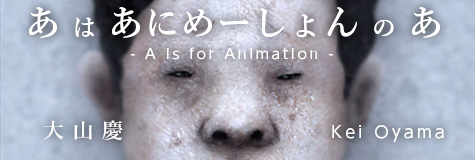
03 HAND SOAP (2) Behind-the-scenes Video
Kei Oyama
I love to observe things at a very close distance.
Speaking in terms of the human body, I like to observe it at the range at which pores are visible. The point-blank distance perceivable by the human eyeball...
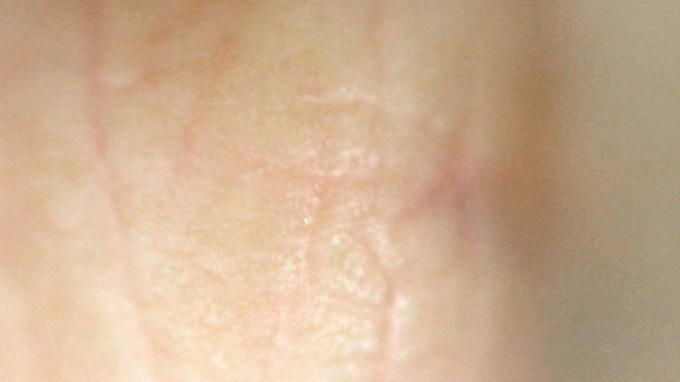 At such a close distance, the skin of even most attractive girls looks grotesque (or sometimes very beautiful). Hangnails, scabs, acne and pimples undergo constant transformations and disappear very quickly, so for me they are particularly interesting.
At such a close distance, the skin of even most attractive girls looks grotesque (or sometimes very beautiful). Hangnails, scabs, acne and pimples undergo constant transformations and disappear very quickly, so for me they are particularly interesting.
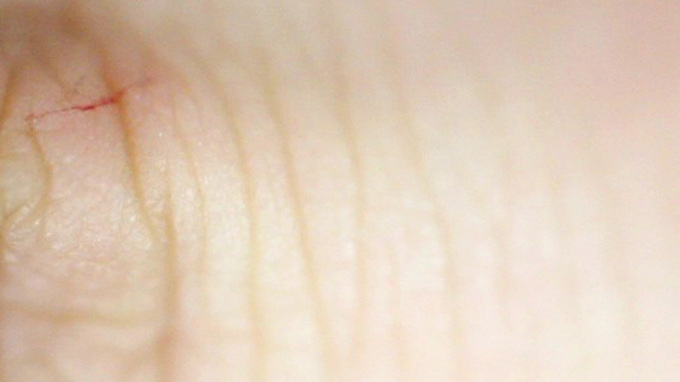 As I explained in the previous installment, HAND SOAP was created by collaging close-up photos. In animation, usually moving images are created by lineal drawing, and then are colored using paints, pastels, or the paint bucket tool on the computer. In HAND SOAP, however, instead of applying colors, I created each single frame by pasting photographs and then adding shades.
As I explained in the previous installment, HAND SOAP was created by collaging close-up photos. In animation, usually moving images are created by lineal drawing, and then are colored using paints, pastels, or the paint bucket tool on the computer. In HAND SOAP, however, instead of applying colors, I created each single frame by pasting photographs and then adding shades.
It is difficult to explain this process with just words, so I suggest we first watch the behind-the-scenes video.
「Making of HAND SOAP」
As you just saw, the lineal drawings that are applied first and serve as guidelines (and even the image sketches made before the start of animation creation) are drawn on a computer. As such, this animation is a fully digital, paperless production, entirely in keeping with the modern trends.
You can catch a glimpse of a TV in the left corner of the screen. When I am at work, concentrating on the creation of an animation, I often play B-grade Hollywood movies, comedy DVDs, or entertainment TV programs, which do not require my full attention, but rather serve as background noise.
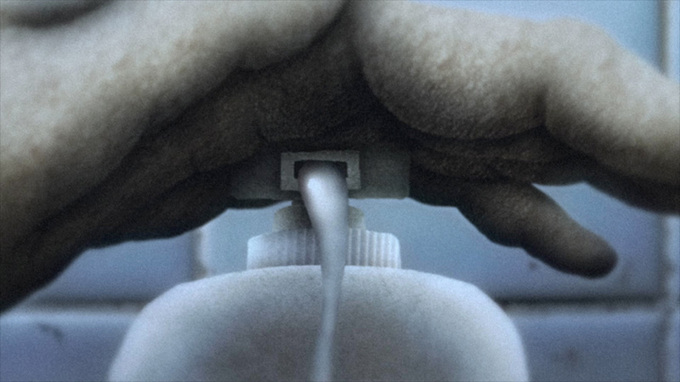 As I explain in the behind-the-scenes video, I do not necessarily use photographs of the same body parts that I depict in the animation. For the lips of the boy, I used a photo of male genitalia, and for the white hand soap liquid - a photo of sperm. I create the images in such a way that the audience will not recognize their source unless it is specifically explained (and sometimes even if it is), but I still enjoy playing with details with the hope that they may generate some hidden meaning.
As I explain in the behind-the-scenes video, I do not necessarily use photographs of the same body parts that I depict in the animation. For the lips of the boy, I used a photo of male genitalia, and for the white hand soap liquid - a photo of sperm. I create the images in such a way that the audience will not recognize their source unless it is specifically explained (and sometimes even if it is), but I still enjoy playing with details with the hope that they may generate some hidden meaning.
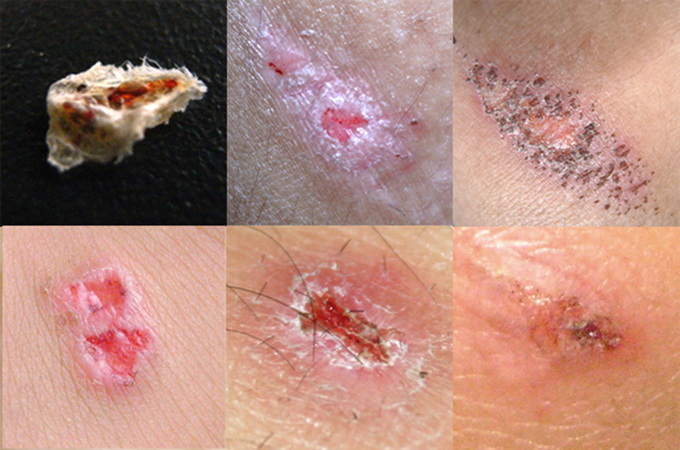 For the scab images, I used a stock of previously taken photos. For most things, photos can be taken when necessary, but scabs are difficult to find or make on the spot, so I have been shooting photos of scabs ever since I came up with this animation technique.
For the scab images, I used a stock of previously taken photos. For most things, photos can be taken when necessary, but scabs are difficult to find or make on the spot, so I have been shooting photos of scabs ever since I came up with this animation technique.
So how did you like this behind-the-scenes video of HAND SOAP? A college student who works for us as a part-timer read this essay and suggested that I'd better rewrite it because it was too gross. I believe I have toned it down quite a bit. Still, there are probably people who find it disgusting and grotesque.
But what I want you to understand is that I am not a gross person, and only chose this peculiar technique because I wanted to express the grotesque period of development that is adolescence. So please, do not hate me.
Till next time.
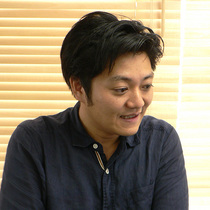 Kei Oyama
Kei Oyama
Animation artist. Born in Tokyo in 1978.
In 2005, Shinsatsushitsu (Consultation Room), his graduation project at Tokyo Zokei University, won the Gold Prize for the Campus Genius Award, as well as Best Picture for BACA-JA. Oyama has been formally invited to international film festivals such as the Directors' Fortnight of the Cannes International Film Festival. In 2008, he made HAND SOAP for Aichi Arts Center which won him many awards including the Grand Prix for the Holland Animation Film Festival and the Special Prize for the International Animation Festival Hiroshima. In the live motion movies Watashi wa neko sutoka (I'm a cat stalker, 2008) and Gegege no nyobo (Gegege's wife, 2010) Oyama was in charge of making the animation clips. He is now a member of CALF, which he founded with his parents, making Hokago (After School) while producing, distributing, and selling animation works.
Official website: http://www.keioyama.com/
CALF: http://calf.jp/
CALF STUDIO: http://calf.jp/studio/
Related Articles
Keywords
Back Issues
- 2022.7.27 Beyond Disasters - T…
- 2022.6.20 Beyond Disasters - T…
- 2021.6. 7 Contributed Article …
- 2021.4.28 Crossing Borders, En…
- 2021.4.27 Contributed Article …
- 2021.4.20 Contributed Article …
- 2021.3.29 Contributed Article …
- 2020.12.22 Interview with the R…
- 2020.12.21 Interview with the R…
- 2020.11.13 Interview with the R…

